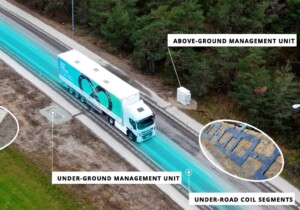Nine hundred and nine days, one concrete strike, and a first-of-its-kind infrastructural civil emergency declaration later, the West Seattle Bridge has reopened to traffic following its closure on March 23, 2020, after large and rapidly growing cracks were discovered by engineers in the support structure of the relatively young span. The September 17 reopening, an event greeted with triumphal horn-honking, filmed reunions, and celebratory tweets of all stripes, brings to an end a years-spanning emergency repair effort that concluded with a final load testing event held early last week.
In announcing the return of a “stronger, safer” West Seattle Bridge to the Emerald City, the Seattle Department of Transportation (SDOT) detailed that repairs entailed creating a new post-tensioning system with 60 miles of steel cables anchored into “specialized” concrete blocks capable of holding more than 20 million pounds of force; wrapping the inside and outside of the concrete girder walls with more than 100,000 square feet of reinforced carbon fiber sheets; and filling the cracked concrete with more than 240 gallons of epoxy. “The bridge is now much stronger than it was before and will last for decades to come,” SDOT proclaimed, adding: “Our engineers and bridge specialists will continue to closely monitor the bridge using cameras, sensors, and frequent in-person inspections.”
UPDATE: The West Seattle Bridge has reopen to westbound & eastbound traffic. pic.twitter.com/yK80aoe08e
— SDOT Traffic (@SDOTtraffic) September 18, 2022
The West Seattle Bridge, a tall and lengthy cantilevered segmental span erected in the early 1980s to replace a bascule predecessor that was struck by a cargo ship in 1978, is the city’s busiest bridge, spanning the Duwamish River southwest of downtown Seattle to provide a vital connection between West Seattle and the rest of the city. Prior to the coronavirus pandemic, the West Seattle Bridge accommodated an average of 100,000 vehicles and 25,000 public transit riders per day. With the reopening, a total of nine King Country Metro bus routes will shift back to the main high-rise bridge beginning today; since its closure, bus traffic to and from West Seattle had been relegated to the Spokane Street Swing Bridge (a.k.a. the “low bridge”), a sluggish route often disrupted by gridlock and ship openings on the Duwamish.
As previously reported by AN, residents of West Seattle, a relatively isolated peninsular patchwork of a dozen-plus park-studded neighborhoods, have long relished the area’s considerable remove from the rest of Seattle (and, historically, the lower housing prices that came along with this remove). However, they do rely heavily on the West Seattle Bridge—officially renamed as the Jeannette Williams Bridge in 2009 after a city council member—as the fastest and most reliable access point to downtown and beyond.
While there are other ways to travel between West Seattle and other parts of the city, including by water taxi, most West Seattle residents have lived with congested detour routes established by SDOT since the beginning of the “traffic trauma”-inducing closure. Or they just rarely left the peninsula. While wildly inconvenient, this major adjustment was made easier by the shift to remote work during the pandemic. Still, during the chaotic first months of the COVID-19 crisis (Seattle was hit hard and early by the virus), the closure of the bridge, referred to by former Seattle Mayor Jenny Durkan as “a lifeline to the local and regional transportation network,” only compounded feelings of isolation for many.
The reopening of the bridge prompted widespread jubilation across West Seattle over the weekend, with at least one watering hole hosting a beer-fueled, multi-day bash; some local businesses celebrated the return of the bridge in other creative ways. As Mike Lindblom wrote for the Seattle Times: “For some West Seattleites, the easier reconnection with the rest of the city put them in a mood to party like it’s 1984. That’s the year the bridge opened, giving the peninsula its first-ever grade-separated transportation mainline — unfettered by railroad tracks and the vagaries of ship traffic — after decades of reliance on ferries, streetcar trestles, and drawbridges.”
Join me for an 11sec vid documenting my first ride on the West Seattle Bridge
Cc @heatherlmarx pic.twitter.com/3QPk6vRBVm— Greg Spotts (@Spottnik) September 19, 2022
In addition to the strengthening and stabilization work at the West Seattle Bridge, SDOT took on other maintenance work at and around the span during the closure including re-pouring concrete panels on its western approach, replacing old expansion joints, and installing new signs. Per the Times, SDOT crews will continue to remove detour signs and temporary lane markings in the coming days.
The closure-including cracks, the result of creep in the bridge’s concrete, were first noted by inspectors in 2013. Over the next several years, however, conditions deteriorated to the point that a total and immediate shut-down was ordered. Repair work on the West Seattle Bridge is estimated to cost $78 million with $37.65 million secured in federal funding. The much-talked-about alternative, scrapping repairs and building an entirely new bridge, was ultimately nixed by Durkan.
At a September 16 reopening ceremony and press conference held before the barricades were removed and bridge ramps officially opened to traffic, U.S. Senator Maria Cantwell stressed the crucial role that federal dollars played in the repair process. “We wanted to make sure that the U.S. Department of Transportation knew how important the West Seattle Bridge was to our residents and to our economy,” said Cantwell. In addition to Cantwell, other attendees of the event included Representative Pramila Jayapal, Seattle Mayor Bruce Harrell, state and city transportation officials, and a slew of local stakeholders. The event was emceed by new SDOT director Greg Spotts, who just arrived to Seattle from Los Angeles where he previously led StreetsLA.
In welcoming back the West Seattle Bridge, which is expected to hold strong until 2060, officials have urged drivers not to speed—and to take public transportation if possible.











